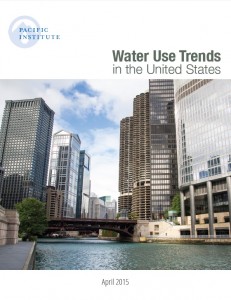Overview
United States water use data is helpful for water management across sectors. Data show that total water use in the United States between 2005 and 2010 was lower than it was in 1970, despite continued population and economic growth. During this time period, per capita water use in the United States declined to levels not seen since the 1940s.
While this report report reveals a trend of overall improvement in the management of the nation’s water, the current pace of water use is still unsustainable. The authors caution that with continued population and economic growth, along with the impacts of climate change, expanded conservation and efficiency measures are necessary to meet future water needs.
This report analyzes and explains the factors contributing to the positive trend of decreasing water use, and examines the implications for future water demand. National water use remains high, and many freshwater systems are under stress from overuse. Climate change will exacerbate existing challenges, affecting the supply, demand, and quality of the nation’s water resources.
Key Findings
Key findings include:
- The economic productivity of water – measured in dollars of gross domestic product per unit of water used – is higher than it has ever been, nearly tripling over the past three decades, from only $4 in 1980 (in 2009 dollars) to more than $11 (in 2009 dollars) of GDP per hundred gallons used. These results show that the United States now produces far more wealth with far less water than at any time in the past.
- Both total water use and freshwater use for thermoelectric power plants have declined since 1970. This represents an important reversal of a 25-year trend of increasing water use for producing energy. The dramatic 20% reduction during the most recent period (2005–2010) has been attributed to upgrades to intakes and cooling systems, as well as the closure of power plants using water-intensive cooling systems. Despite these improvements, thermoelectric power plants remain the single largest user of water in the United States.
- Municipal and industrial (M&I) water use represents the amount of water withdrawn to meet the needs of cities, towns, and small communities, including individual households. M&I water use peaked in 1980 and has been steadily declining since. By 2010, M&I water use was less than it was in 1965. Reductions in per capita M&I water demand were driven by two major factors: the economic shift from water-intensive manufacturing to a service-oriented economy; and numerous federal, state, and local policies and actions. Household water use had been steadily increasing since 1950s but, for the first time ever, decreased between 2005 and 2010.
- In 2010, agricultural water use accounted for 40% of total national use. Water use for irrigation peaked in 1980 and has declined in nearly every period since. By 2010, water use for irrigation was at its lowest level in more than 40 years. Yet irrigated acreage has continued to increase, with 62 million acres irrigated in 2010, the most at any time in United States history. Reductions in water intensity could be due to several factors, including shifting to less water-intensive crops, as well as improvements in irrigation technologies and practices.


